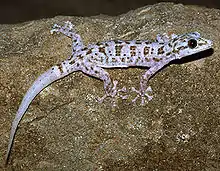Phyllodactylus xanti
Phyllodactylus xanti, also known commonly as the leaf-toed gecko or the peninsular leaf-toed gecko, is a species of lizard in the family Phyllodactylidae. The species is native to California and adjacent northwestern Mexico. There are four recognized subspecies.
| Phyllodactylus xanti | |
|---|---|
 | |
| Scientific classification | |
| Kingdom: | Animalia |
| Phylum: | Chordata |
| Class: | Reptilia |
| Order: | Squamata |
| Family: | Phyllodactylidae |
| Genus: | Phyllodactylus |
| Species: | P. xanti |
| Binomial name | |
| Phyllodactylus xanti | |
Geographic range
P. xanti is found in extreme southern California in the United States, and in the Baja California Peninsula and associated islands in Mexico.[1][3]
Description
P. xanti has vertical pupils, immovable eyelids, and leaf-like toe pads. It has a brownish, grey, or pinkish dorsum, with a light venter. The granular dorsal scales are interspersed with tubercles.
It often squeaks when handled, and it has a very fragile tail which is readily lost.
This gecko is between 2.5 and 6.2 cm (1.5 and 2.5 inches) in snout-to-vent length (SVL).
Subspecies
Four subspecies are recognized as being valid, including the nominotypical subspecies.[3]
Etymology
The specific epithet, xanti, commemorate John Xantus,[4] a nineteenth century naturalist active in the United States of America.[5]
The subspecific names, sloani and zweifeli, are in honor of American herpetologists Allan John Sloan and Richard G. Zweifel, respectively.[5]
Taxonomy
The accepted scientific name and original description were published in 1863 by Edward Drinker Cope.[3]
References
- Hammerson GA (2007). "Phyllodactylus xanti ". The IUCN Red List of Threatened Species. IUCN. 2007: e.T64051A12740152. doi:10.2305/IUCN.UK.2007.RLTS.T64051A12740152.en. Retrieved 15 January 2018.
- "Phyllodactylus xanti Cope, 1863". ITIS (Integrated Taxonomic Information System).
- Phyllodactylus xanti at the Reptarium.cz Reptile Database.
- a.k.a. Louis deVesey (1825-1894).
- Beolens, Bo; Watkins, Michael; Grayson, Michael (2011). The Eponym Dictionary of Reptiles. Baltimore: Johns Hopkins University Press. xiii + 296 pp. ISBN 978-1-4214-0135-5. (Phyllodactylus xanti, p. 291; P. x. sloani, p. 246; P. nocticolus zweifeli, p. 294).
Further reading
- Behler JL, King FW (1979). The Audubon Society Field Guide to North American Reptiles and Amphibians. New York: Alfred A. Knopf. 743 pp. ISBN 0-394-50824-6. (Phyllodactylus xanti, p. 494 + Plate 391).
- Bostic DL (1971). "Herpetofauna of the Pacific coast of north central Baja California, Mexico, with a description of a new subspecies of Phyllodactylus xanti ". Transactions of the San Diego Society of Natural History 16: 237–263. (Phyllodactylus xanti sloani, new subspecies, pp. 252–254, Figures 7–8).
- Cope ED (1863). "Descriptions of new American SQUAMATA, in the Museum of the Smithsonian Institution, Washington". Proc. Acad. Nat. Sci. Philadelphia 15: 100–106. (Phyllodactylus xanti, new species, pp. 102–103).
- Dixon JR (1964). "The Systematics and Distribution of Lizards of the Genus Phyllodactylus in North and Central America". New Mexico State University Scientific Bulletin 64 (1): 1–139. (Phyllodactylus xanti zweifeli, new subspecies, pp. 59–62).
- Dixon JR (1966). "Speciation and systematics of the gekkonid lizard genus Phyllodactylus of the Islands of the Gulf of California". Proceedings of the California Academy of Sciences, Fourth Series 33 (13): 415–452. (Phyllodactylus xanti acorius, new subspecies, pp. 442–443).
- Smith HM, Brodie ED Jr (1982). Reptiles of North America: A Guide to Field Identification. New York: Golden Press. 240 pp. ISBN 0-307-13666-3. (Phyllodactylus xanti, pp. 70–71).
- Stebbins RC (2003). A Field Guide to Western Reptiles and Amphibians, Third Edition. The Peterson Field Guide Series ®. Boston and New York: Houghton Mifflin. xiii + 533 pp. ISBN 978-0-395-98272-3. (Phyllodactylus xanti, p. 266 + Plate 24 + Map 73).
